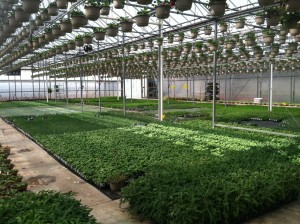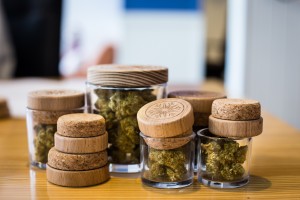By Alex Cooley, Solstice
Growing greener has been making the news. Or rather, the cannabis industry’s habit of scaling up largely unsustainable grow methods in big production facilities is on the national radar.

One widely circulated quote equates the carbon footprint of producing a gram of hydroponically grown cannabis to that of “driving seventeen miles in a Honda Civic.” And while that beats seventeen miles in a Hummer, it’s a number we have the power to greatly reduce. Part of what excites me about this freshly-legal industry is that we have the opportunity to shape it in a way that big business has thus far failed to do by not putting a higher profit margin above the health of the planet.
In August I was asked to speak about this very topic in Las Vegas at the 2nd annual NCIA Southwest CannaBusiness Symposium. It gave me a chance to reflect on something I’m passionate about – the real environmental impact of what we do, what isn’t working, and how we can create positive change for this and future generations of growers and patients.
Get Under The Sun
- It takes vast resources to power a warehouse grow that relies on High Intensity Discharge (HID) or High Pressure Sodium (HPS) lights. Automated light deprivation greenhouses can produce cannabis of equal or greater value as that produced indoors at half the cost and one quarter the environmental impact.
- Cannabis used for extracts can all be grown outdoors. Provided you live in a climate that allows for outdoor cultivation, sun-grown cannabis is excellent starting material for extractions. The finished form will be far from the flower, so why not take advantage of one of our most powerful (and free!) resources?

Keep It Lean Indoors
I know that not every method of cultivation can rely exclusively on solar power. However, in indoor grows, we can focus on efficiency.
- For most indoor grows, Heating, Ventilation, and Air Conditioning (HVAC) systems are a huge resource suck. I’ve discovered that the best method is to utilize a centralized Variable Air Volume (VAV) system.
- Make sure the envelope is sealed. Keep your buildings well insulated to prevent energy leaks. Without a higher energy code and tighter insulation, many industrial-scale grows hemorrhage energy and resources.
Lay Down the Law
Frankly, some of the cities and states currently passing laws to regulate cannabis cultivation have the least enviable power infrastructures. Las Vegas, which relies heavily on coal and natural gas, is ahead of the curve in terms of legislation, whereas clean n’ green hydro-electrically-powered Washington State has yet to create stringent and sustainable regulations. Legislators have been more concerned with issues of security and diversion than environmental impact. The “pot is dangerous” paradigm needs to shift to “unregulated grow practices are dangerous for the planet.”
Nice Package…
We can effectively undo all the good of a smart grow with wasteful packaging.

- Think cradle-to-grave for your packaging: Where did it come from? What is it made of? Where will it go after it has been used? That plastic container might be a good fix in a pinch, but think about the impact it has as you scale.
- We’ve got to reduce plastics and push glass, wood, or paper wherever possible. Almost every gram of cannabis that goes out into the world from a processing facility is wrapped in plastic – and we all know that it can’t be properly disposed of or recycled. However, the plastic used for business-to-business bulk orders could be saved and reused.
- At Solstice we’ve been designing glass containers with cork and wood tops for our flower. They can be collected, reused, or returned for a deposit. Our pre-rolls are made from 60% post-consumer recycled paper and printed with vegetable ink. Every little bit counts.
Have Multiple Bottom Lines
The “Triple P bottom line: People, Planet, Profits” is the newest, sexiest take on commerce with a conscience. The Triple P works primarily because it’s a flexible paradigm; it gives business owners a framework in which they can question and evaluate the human and environmental cost of every move they make.
Across industries, innovative leaders are finding more generous, humane, and ultimately more sustainable ways to do big business. Some of these are easy and inexpensive: utilizing proper waste disposal, bike-to-work incentive programs (a Solstice favorite), Plant-A-Tree days, or making sure your pesticide program is safe for employees and the planet.
Sometimes however, there is an unavoidable immediate cost to doing what’s right. Google uses a fancy fuel cell with 2-3 bloom boxes for their building infrastructure. They’re getting loads of good PR for this – in part because very few people can afford to use them.
But it is my belief that the more you grow, the more capital you’re bringing in, the more you have to give to impeccable resource management.
Everyone knows that cannabis makes money; we’re looking at a multi-billion dollar industry over the next 5 years. Hobby systems and garage standards are not scalable for the cannabis boom. Whatever the laws might ‘allow’ us to do, we have to stay ahead of the curve and firmly within our own conscience.
Alex Cooley is the owner of Solstice, a member of NCIA since April 2013. Solstice founded their Seattle-based flagship in 2011 as the first-ever permitted cannabis production facility in Washington State. Solstice has taken an environmentally conscious approach to high quality cannabis production and has cultivated over 350 different types of cannabis, creating one of the most robust genetic libraries anywhere in the world.

Follow NCIA
Newsletter
Facebook
Twitter
LinkedIn
Instagram
–